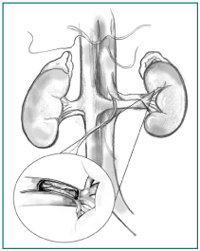Renal artery stenosis pathophysiology
|
Renal artery stenosis Microchapters |
|
Diagnosis |
|---|
|
Treatment |
|
Case Studies |
|
Renal artery stenosis pathophysiology On the Web |
|
American Roentgen Ray Society Images of Renal artery stenosis pathophysiology |
|
Risk calculators and risk factors for Renal artery stenosis pathophysiology |
Overview
Pathophysiology
The macula densa of the kidney senses a decreased systemic blood pressure due to the pressure drop over the stenosis. The response of the kidney to this decreased blood pressure is activation of the renin-angiotension aldosterone system, which normally counteracts low blood pressure, but in this case lead to hypertension (high blood pressure). The decreased perfusion pressure (caused by the stenosis) leads to decreased blood flow (hypoperfusion) to the kidney and a decrease in the GFR. If the stenosis is long standing and severe the GFR in the affected kidneys never increases again and (pre-renal) renal failure is the result.
